-
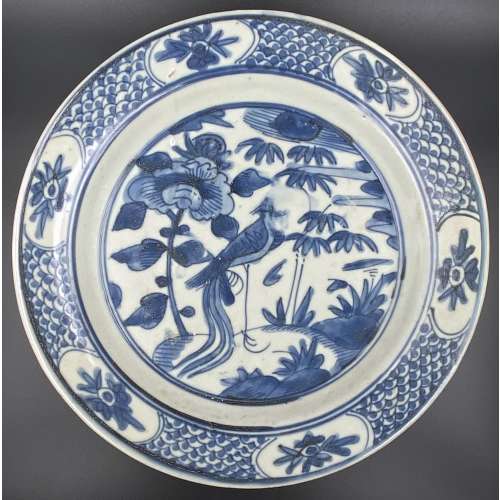 Underglaze cobalt blue and white Zhangzhou (Swatow) porcelain plate decorated vigorously and spontaneously with a bird in the landscape, and flowers in oval cartouches among waves or fish scale diaper. Sand particles on the base. Ming Dynasty [大明] (1368 – 1644); Wanli Era (1572 – 1620); Late 16th – Early 17th century. Diameter: 28.2 cm; Height: 4.0 cm
Underglaze cobalt blue and white Zhangzhou (Swatow) porcelain plate decorated vigorously and spontaneously with a bird in the landscape, and flowers in oval cartouches among waves or fish scale diaper. Sand particles on the base. Ming Dynasty [大明] (1368 – 1644); Wanli Era (1572 – 1620); Late 16th – Early 17th century. Diameter: 28.2 cm; Height: 4.0 cm -
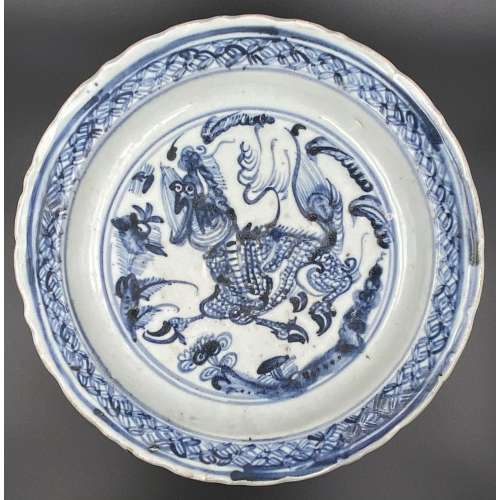 Footed plate with scalloped rim, centre decorated with running yak or another even-toed animal among flowers, jewel diaper pattern to the inner lip; foliage motif to the outside is bordered with foliage above and lotus leaves below. Porcelain with underglaze blue decoration. Ming Dynasty [大明] (1368 – 1644); Wanli Era (1572 – 1620); Late 16th – Early 17th century. Diameter: 25.5 cm; Height: 4.2 cm
Footed plate with scalloped rim, centre decorated with running yak or another even-toed animal among flowers, jewel diaper pattern to the inner lip; foliage motif to the outside is bordered with foliage above and lotus leaves below. Porcelain with underglaze blue decoration. Ming Dynasty [大明] (1368 – 1644); Wanli Era (1572 – 1620); Late 16th – Early 17th century. Diameter: 25.5 cm; Height: 4.2 cm -
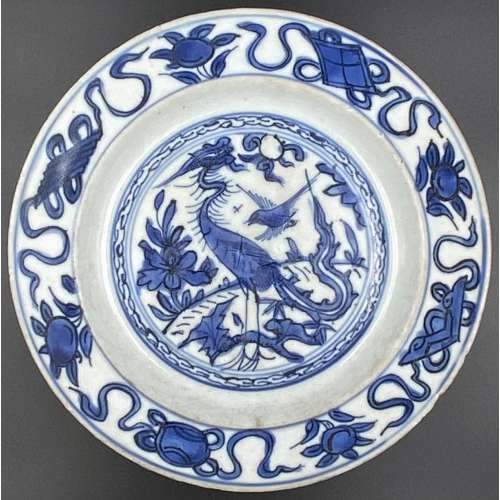 Plate with crane, bird, plants, and four treasures. Porcelain with underglaze blue decoration and illegible factory mark to the bottom. Ming Dynasty [大明] (1368 – 1644); Wanli Era (1572 – 1620); Late 16th – Early 17th century. Diameter: 19.5 cm; Height: 3 cm
Plate with crane, bird, plants, and four treasures. Porcelain with underglaze blue decoration and illegible factory mark to the bottom. Ming Dynasty [大明] (1368 – 1644); Wanli Era (1572 – 1620); Late 16th – Early 17th century. Diameter: 19.5 cm; Height: 3 cm -
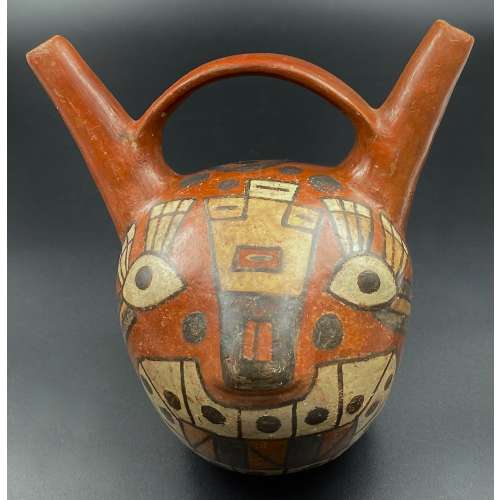 Pre-Columbian, Peru, Wari (Huari) culture, ca. 650 to 1000 CE.
Pre-Columbian, Peru, Wari (Huari) culture, ca. 650 to 1000 CE.A hand-built polychrome ceramic stirrup vessel depicting the head of a jaguar. Painted with a sienna-hued base, this spotted beast features an abstract visage of almond-shaped eyes opened wide with long feather-like lashes, a rectangular nose protruding from a nasal bridge decorated with a quadrilateral motif, and a large open mouth, showing both upper and lower teeth, which are also spotted, all painted in shades of cream, black, cream, grey, light grey, and beige. Highly burnished, the lustrous vessel exhibits two spouts, also functioning as ears of the jaguar, with a flat handle arching between them. This tool would have been a grave good intended to hold some kind of libation or offering and was likely made in a specialist workshop.
Colours: Sienna (base), black, cream, grey, light grey, beige (7 colours).
Dimension: Width (mouth-to-mouth): 15 cm; Height: 14.5 cm; Diameter of the body: 10.5 cm. Provenance: Hans Juergen Westermann collection, Germany. The Wari State was the first expansionistic power to develop in the Andean highlands. It was located in Vilcabamba, modern Espiritu Pampa (Plain of the Spirits), Echarate District of La Convención Province in the Cuzco Region of Peru. The Wari expanded around AD 650 and by the time of their collapse in AD 1000 they controlled much of the central Andes. -
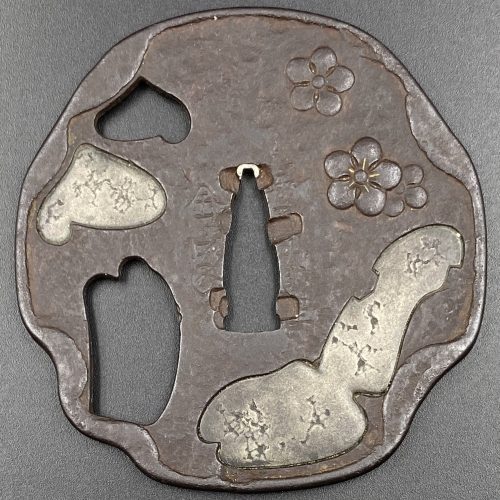
A very thin kobushi-gata form iron tsuba decorated in openwork (sukashi), some openings filled with grey metal (silver or pewter) treated in a way to resemble cracked ice, ginkgo leaf to recto and plum blossoms to verso in low-relief (takabori) and gold inlay (zōgan), and unevenly folded over rim (hineri-mimi). The overall theme of the piece is linked to the icy ponds, falling ginkgo leaves and blossoming plums in the late winter.
Size: 84 x 80 mm, thickness (center): 2 mm.Signed: Yamashiro no kuni Fushimi no ju Kaneie [Kaneie of Fushimi in Yamashiro Province] [山城國伏見住金家], with Kaō.
Probably the work of Meijin-Shodai Kaneie (c. 1580 – 1600).
The silver or pewter inlays likely a later work that may be attributed to Goto Ichijo (1791 – 1876) or one of his apprentices in the late 19th century, possibly as a tribute to the great Kaneie masters. Here is an article by Steve Waszak dedicated to Kaneie masters and this tsuba in particular.Kaneie
For many tosogu aficionados, this name reigns supreme among all tsubako across Japanese history. The first Kaneie is celebrated for many things. He is recognized as being the first ever to bring pictorial landscape subjects to a canvas so small as that of a tsuba plate. His skill in being able to render classical Chinese landscape themes while working with a material as unyielding as steel, and to do so with the sensitivity he does, is nothing short of astounding. The quality of his workmanship — especially that of his exquisitely carved motif elements and the extraordinary deftness of his tsuchime (槌目 or 鎚目, hammer-blow) utilizing such thin plates — astonishes even to this day. His sensibilities concerning the shaping of his sword guards and the presentation of the rims were no less innovative than his subject matter. He was among the very first to regularly sign his name as a tsuba smith. And it is likely that he served the great warlord Toyotomi Hideyoshi in the latter years of the 16th century. Despite the great fame and reputation of Kaneie, very little of the lives of the two men who are seen by most scholars as the “true Kaneie” tsubako of the Momoyama and earliest Edo Periods is known to us now. They were both smiths working in steel, with occasional added soft-metal inlay (usually serving to highlight features), and both made sword guards of the same style, using subject matter focused on landscapes, allusions to historical events, or religious themes. The first of these men is often referred to as “O-Shodai,” or Great First Generation, while the second is known as “Meijin-Shodai,” or Famous First Generation. While some see subsequent generations stemming from these first two men, others have the O-Shodai and the Meijin-Shodai as THE two true Kaneie and make a sharp distinction between these two smiths and any others who may share the name.The work of the O-Shodai may appear with two different mei. One of these is written “Joshu Fushimi Ju Kaneie,” while his work may also carry a mei reading “Yamashiro no Kuni Fushimi Ju Kaneie.” It is thought by some scholars that the earlier works present with the “Joshu” mei, while his later works feature the “Yamashiro” mei. However, there are only some five or six tsuba extant with the “Joshu” signature, so we should not necessarily see works with the “Yamashiro” signature as dating only to the latest years of his working life. The answers to the questions of exactly when Kaneie might have begun his life as a tsubako, or how old he was when he moved to sign his works with the “Yamashiro” mei, will probably remain shrouded in uncertainty.The association between Kaneie and Toyotomi Hideyoshi is speculative, to be sure, but the circumstantial evidence is tantalizing. The area of Fushimi is thought to have been an entirely unremarkable land prior to Hideyoshi’s building of a castle there, so it would seem unlikely that the first Kaneie would have been working in such a nondescript place, much less including the place name in his mei, before Hideyoshi’s putting it on the map, so to speak. Why emphasize such pride of place in one’s signature unless the place itself carries a certain weight? The name “Kaneie” translates roughly to “gold family,” which, given Hideyoshi’s notorious love of gold, would seem too much of a coincidence when combined with the explicit mention of Fushimi in the signatures. Combine this with the consideration of what is an equally compelling relationship between the celebrated tsubako Nobuie and Oda Nobunaga (“Nobuie” means roughly “of the family of “Nobu”), whom Hideyoshi served as a top general until Oda’s demise in 1582, and the circumstantial evidence becomes even harder to deny the plausibility of. Oda, ever the innovator, may have been the one responsible for birthing the practice of tsubako regularly signing their works. Having a superb smith like Nobuie affix the name to the tsuba as a regular practice establishes a sort of “brand name,” a brand coming with the seal of approval of Oda Nobunaga. It is more than possible that Nobunaga may have then used these valuable sword guards as rewards given to vassals and other important relations to honour them for their services to him, a practice that would have allowed Nobunaga to avoid having to use gold, guns, swords, horses, or land to do so. The awarding of a magnificent Nobuie tsuba to a deserving warrior, an appreciated ally, or a family member would bring honour to the recipient, of course, but would also honour the maker of the sword guard, and even the giver of the object. Such a way of thinking would be absolutely typical of him, and given that both Oda Nobunaga and Nobuie were men of Kiyosu in Owari in the early Momoyama Period, it does not strain credulity to imagine that the above dynamic could have occurred in just this way. If indeed it did, Toyotomi Hideyoshi is unlikely to have let this pass unnoticed. He may even have been so honoured himself! When he rose to power very shortly after Oda’s death, then, and when he reinforced and consolidated that power in the late 1580s and early 1590s, which included the building of the castle at Fushimi, perhaps he sought to emulate the Oda vision and practice of establishing a “royal tsubako.” If so, Kaneie would have been that smith.As noted, this scenario is speculative, and not a little romantic. This does not mean, however, that it is in fact not likely, for there would be a number of coincidences involved for it to be entirely false.Tsuba scholars will say that Kaneie’s skills in the making of his sword guards indicate an armour-making background. This is an interesting viewpoint, but one can’t help but wonder how many armourers were possessed of such fluent literacy in lyrical Chinese historical tales that they could then represent them as motifs on steel plates. Kaneie subjects often are in the form of Chinese landscapes and allusions, as noted, one of which — The Eight Views of the Xiao and the Xiang — was very well known as a famous subject of Chinese painting and poetry from the Song Dynasty. There exist Kaneie tsuba which depicts at least some of these “views,” and it seems unlikely that if one or more of them were to be created, not all of them would be, in a sort of “series.” The cultural and literary fluency Kaneie would seem to have had, then, may suggest a Buddhist background, and indeed, some of the subjects seen are explicitly Buddhist in nature. Perhaps his background then, somehow offering a dovetailing of metalwork and Buddhist teachings; in any event, we are all the richer for at least some of the works of Kaneie to have survived to reach us today.One of the hallmarks of Kaneie tsuba (real ones) is the extreme thinness of the plate, combined with utterly superb tsuchime expression of that plate. To be able to hammer the plate to achieve such strength of expression while the plate is so thin is seen by the Japanese as practically miraculous. A notable and important kantei point between the early masterpieces by the two “Shodai” Kaneie and the tsuba made by followers is this thinness of the plate. Another kantei point: because the plate is so thin when raised areas representing motif elements are present, they are inlaid into the plate, because trying to carve them from such a thin plate would be practically impossible: the likelihood of piercing the plate would be high, and the plate in that area, even if not pierced, would be significantly weakened by trying to manage the raising of a motif element from the plate. In real Kaneie works, then, one would expect any raised motif elements to be inlaid.Other highlights: the “Shodai” Kaneie are famous for the kobushi-gata (拳形) or “fist-shaped” design in their work, but despite this, there actually aren’t that many extant sword guards boasting this shape. Another feature for which the Kaneie are justly famous is their folding over of the lip of the rim onto the plate in a very tasteful manner, just here and there, rather than uniformly across the tsuba. However, again, this feature is actually not commonly seen, either. The combination, then, of a kobushi-gata shape with the rim folded over in just a few areas is that much rarer.Which brings us to the featured piece.Here is a Kaneie tsuba, a “Meijin-Shodai” Kaneie, which presents with a very thin plate, being between 1.5 and 2mm in thickness. The motif elements are inlaid, as we should expect. The sugata (姿, shape) is Kobushi-gata with the rim folded over in only a few places, representing a relatively infrequently encountered form, as stated. The tsuba here is fortunate not to have any added hitsu-ana, unlike many or most other Kaneie do. The sukashi elements are fascinating to consider, being difficult to determine the meaning of; however, the raised elements clearly point to a seasonal motif, with cherry and plum blossoms on the omote for Spring, and ginkgo on the ura for Fall. The inlaid metal in two of the openings — silver, shibuichi, or pewter, perhaps — is very likely a later addition, probably 19th-century, and more specifically, late-19th-century. The finishing on these inlaid portions has all the hallmarks of Goto Ichijo workmanship. Namely, the treatment of the surface of the inlay to resemble fallen snow (in the Japanese sense of things) is expressed in a very Ichijo sense of things, and, given the great importance of Kaneie tsuba, and the seasonal expression the motif of the guard has, it is plausible that the inlay is Ichijo work or that of one of his top students. In any event, this inlay complements the rest of the tsuba beautifully. The inlay also resembles the art of kintsugi (金継ぎ, golden joinery) or the Japanese practice of ceramic repair using lacquer when a piece is particularly special or important. In this way, a nod is given to Tea Culture, too, creating a wonderful blending of associations and allusions, typical of the highest Japanese aesthetic sense.At 8.4cm, the tsuba is of an excellent size and is in great condition (no rust, no deep rust pitting, no fire damage). There is, intriguingly, one small sign of battle damage at 6:00 on the guard: it would seem a sword blow cut into the tsuba at the rim, and penetrated slightly into the plate. The superb repair represented by a little stitch or two right at the rim and along a few millimetres of the plate is visible on very close inspection. The repair is old, probably nearly contemporary with when the tsuba was made. Given the high status of Kaneie in their lifetime (as tsubako for Hideyoshi, one might imagine their importance), and given the obvious high quality of this piece, it is not surprising that the finest repair efforts were put into its care.The name Kaneie justly enjoys its fame and accolades as pre-eminent among the tens of thousands of tsubako in Japanese history. We are fortunate indeed to have had a small number of the works of the early masters survive to this day. The first of their kind, and as most scholars and aficionados would wholeheartedly agree, the best of their kind, Kaneie sword guards remain among the very finest examples of the Japanese metal-working traditions. -
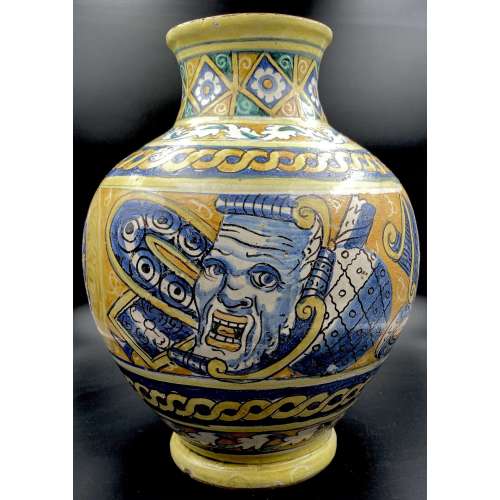
-
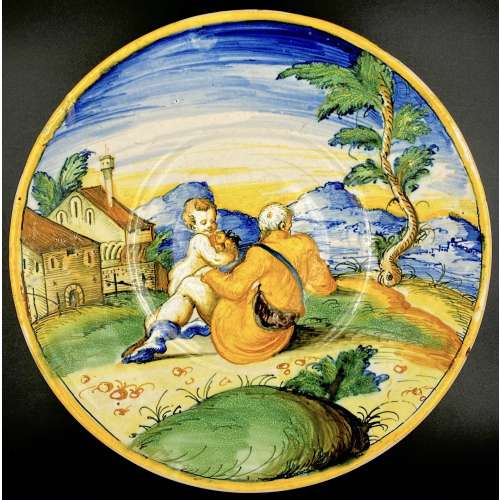
-
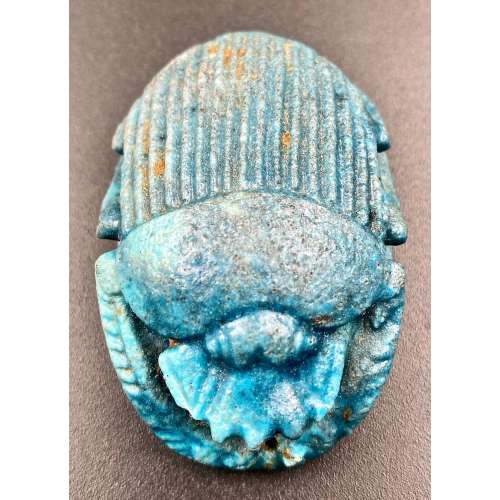 Egypt, Late Period. The oval amulet with multiple pierced holes for stitching to the outer garments of a mummy or the mummy wrappings, reeded wings and braided claws, marine blue in colour. According to the Brooklyn Museum, such faience amulets formed part of the beadwork pattern and served to protect the mummy through their magical properties. It served as a substitute heart that would ensure continued existence in the hereafter. A similar example at the Brooklyn Museum dated ca. 712-342 BC. Dimensions: 55 x 37 mm Provenance: The Collection of Erwin Harvith (1918 – 2011) and Sylvia Redblatt Harvith (1920 – 2015), Detroit, MI, acquired in 1972 directly from the Collection of Moshe Dayan, (משה דיין; 1915 – 1981), an Israeli military leader and politician. Exhibited: Jewish Museum, New York, NY, "Culture and Continuity – The Jewish Journey", 1975.
Egypt, Late Period. The oval amulet with multiple pierced holes for stitching to the outer garments of a mummy or the mummy wrappings, reeded wings and braided claws, marine blue in colour. According to the Brooklyn Museum, such faience amulets formed part of the beadwork pattern and served to protect the mummy through their magical properties. It served as a substitute heart that would ensure continued existence in the hereafter. A similar example at the Brooklyn Museum dated ca. 712-342 BC. Dimensions: 55 x 37 mm Provenance: The Collection of Erwin Harvith (1918 – 2011) and Sylvia Redblatt Harvith (1920 – 2015), Detroit, MI, acquired in 1972 directly from the Collection of Moshe Dayan, (משה דיין; 1915 – 1981), an Israeli military leader and politician. Exhibited: Jewish Museum, New York, NY, "Culture and Continuity – The Jewish Journey", 1975. -
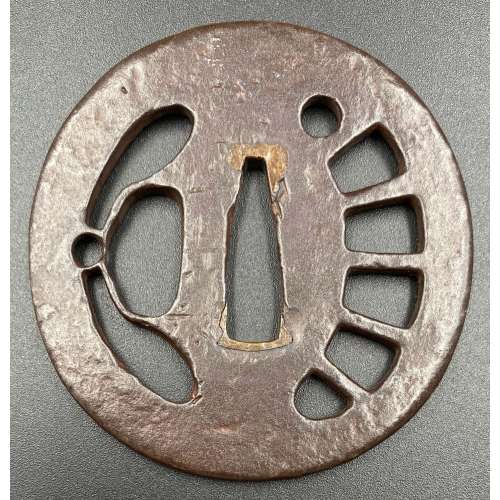
Oblong round shape (nagamaru-gata) tsuba with design of dragonfly (tombo or katsumushi) and wheel (kuruma) in negative openwork (kage-sukashi), round rim (maru-mimi ). Copper sekigane.
Okamoto Yasukazu's Owari to Mikawa no tankō, №181 characterizes the tsuba as follows: "Katsumushi, kuruma-sukashi no zu (dragonfly and wheel sukashi). Mei: Yamakichibei (Shodai). Such small tsuba are rare for the Shodai. The nakago-ana is also small so it was probably intended to be mounted on a tantō. Regardless of its size, the iron is outstanding and the workmanship shows the characteristic features of the Shodai (first generation). The kuruma-sukashi design is interpreted here in a half-moon shape and only on one side of the tsuba. Such a design is also seen on works of the Nidai (second generation)...". Signed to the left of nakaga-ana: Yamakichibei (山吉兵へ). Attributed to the First Generation (Shodai) master.
NBTHK paper (translated by Markus Sesko): The Tokubetsu-Kichō Kodōgu. Kachimushi-kuruma sukashi-tsuba (勝虫車透鐔) - Tsuba with sukashi motif of dragonfly and cartwheel. Signed: Yamakichibei (山吉兵). Iron, marugata, ko-sukashi. Issued on April 1, 1977. [Copy only] Dimensions: H: 66 mm; W: 63.2 mm; Th(center): 3.8 mm; Th(rim): 3.5 mm. Weight: 68 g. -
 Iron tsuba of round form adorned with the design of stars, wild geese, floating blossoms, leaves and tendrils realized in brass inlay. The inlay technique includes suemon-zōgan and ten-zōgan. Two smaller openings (hitsu-ana) surrounded by a scalloped brass border. The seppa-dai border inlay is missing, as well as a few other fragments of inlay on both sides. Sword cut at 12 o'clock on the reverse. A tsuba with a strong autumnal connotation, which once belonged to a great battle weapon. One of only three known jūyō Ōnin tsuba. Translation of the paper, issued by the Japanese sword fittings (tosogu) examination board: Designated as jūyō-tosogu at the 34th jūyō-shinsa held on April 14th 1988 Kaki-karimon zōgan-tsuba (花卉雁文象嵌鐔) — Tsuba with zōgan design of flowers and wild geese. Mumei: Onin (応仁) Tokyo. Nakasono Tokumi (中園とくみ) Measurements: height 9.5 cm, width 9.4 cm, thickness at rim 0.35 cm Interpretation: marugata, iron, brass zōgan, two hitsu-ana Time: end of Muromachi Explanation: Ōnin-tsuba are thin iron ita-tsuba which show a brass zōgan ornamentation. All of them are mumei and there is the theory that they were made in the Onin era (1467-1469) although today more and more the theory is accepted that they are in general late Muromachi period works. There are two kinds of brass zōgan interpretations: One depicts irregularly arranged tachibana branches, wild geese, chrysanthemums, flowers, or karakusa for example, and the other one shows punctual zōgan elements, which are referred to as hoshi-zōgan or ro-zōgan, and concentrical zōgan elements between the nakago-ana and the rim. The latter interpretations might also be accompanied by simple ko-sukashi in the form of butterflies, clouds, hats, or stylized mountains. This tsuba is a typical work from the former category. It is large and feels massive and the powerful and impressive zōgan and the excellent iron make it a highly tasteful piece. Back side: Issued to: Nakasono Tokumi Address: Tokyo-to, Suginami-ku, Kamitakaido 2-17-26 Date of issue: May 30th 1989
Iron tsuba of round form adorned with the design of stars, wild geese, floating blossoms, leaves and tendrils realized in brass inlay. The inlay technique includes suemon-zōgan and ten-zōgan. Two smaller openings (hitsu-ana) surrounded by a scalloped brass border. The seppa-dai border inlay is missing, as well as a few other fragments of inlay on both sides. Sword cut at 12 o'clock on the reverse. A tsuba with a strong autumnal connotation, which once belonged to a great battle weapon. One of only three known jūyō Ōnin tsuba. Translation of the paper, issued by the Japanese sword fittings (tosogu) examination board: Designated as jūyō-tosogu at the 34th jūyō-shinsa held on April 14th 1988 Kaki-karimon zōgan-tsuba (花卉雁文象嵌鐔) — Tsuba with zōgan design of flowers and wild geese. Mumei: Onin (応仁) Tokyo. Nakasono Tokumi (中園とくみ) Measurements: height 9.5 cm, width 9.4 cm, thickness at rim 0.35 cm Interpretation: marugata, iron, brass zōgan, two hitsu-ana Time: end of Muromachi Explanation: Ōnin-tsuba are thin iron ita-tsuba which show a brass zōgan ornamentation. All of them are mumei and there is the theory that they were made in the Onin era (1467-1469) although today more and more the theory is accepted that they are in general late Muromachi period works. There are two kinds of brass zōgan interpretations: One depicts irregularly arranged tachibana branches, wild geese, chrysanthemums, flowers, or karakusa for example, and the other one shows punctual zōgan elements, which are referred to as hoshi-zōgan or ro-zōgan, and concentrical zōgan elements between the nakago-ana and the rim. The latter interpretations might also be accompanied by simple ko-sukashi in the form of butterflies, clouds, hats, or stylized mountains. This tsuba is a typical work from the former category. It is large and feels massive and the powerful and impressive zōgan and the excellent iron make it a highly tasteful piece. Back side: Issued to: Nakasono Tokumi Address: Tokyo-to, Suginami-ku, Kamitakaido 2-17-26 Date of issue: May 30th 1989 -
 Iron tsuba of six-lobed (mutsu-mokkō-gata) form, with six wild boar's eye shape (inome) openings (sukashi). Ryo-Hitsu and the entire perimeter of tsuba have typical for this school raised rim; raised seppa dai. Lobes are decorated in low relief carving (sukidashi-bori). On the obverse: chrysanthemum, Genji mon, waves and rocks, grasses and star, bellflower, star and flower in tortoiseshell (kikko). On the reverse: Stars and different flowers, and flying geese. The plate is damaged to the left of nakago-ana and around the left hitsu-ana. Kamakura-bori school. Late Muromachi period (1514-1573). Diameter: 89 mm; Thickness at seppa-dai: 4.0 mm; Weight: 108.8 g [large]. There is a similar tsuba in this collection, TSU-0345.2018, but with a different motif and much smaller: diameter 74.3 mm, thickness at seppa-dai: 3.2 mm, weight: 62.8 g.Another look-a-like tsuba can be found at the Compton Collection, part II, pp. 14-15, №17, though his tsuba is more massive (80 x 84 x 4 mm).
Iron tsuba of six-lobed (mutsu-mokkō-gata) form, with six wild boar's eye shape (inome) openings (sukashi). Ryo-Hitsu and the entire perimeter of tsuba have typical for this school raised rim; raised seppa dai. Lobes are decorated in low relief carving (sukidashi-bori). On the obverse: chrysanthemum, Genji mon, waves and rocks, grasses and star, bellflower, star and flower in tortoiseshell (kikko). On the reverse: Stars and different flowers, and flying geese. The plate is damaged to the left of nakago-ana and around the left hitsu-ana. Kamakura-bori school. Late Muromachi period (1514-1573). Diameter: 89 mm; Thickness at seppa-dai: 4.0 mm; Weight: 108.8 g [large]. There is a similar tsuba in this collection, TSU-0345.2018, but with a different motif and much smaller: diameter 74.3 mm, thickness at seppa-dai: 3.2 mm, weight: 62.8 g.Another look-a-like tsuba can be found at the Compton Collection, part II, pp. 14-15, №17, though his tsuba is more massive (80 x 84 x 4 mm).
Varshavsky Collection: TSU-0345.2018
This tsuba, TSU-0401.2019, is the biggest of all three (another mine and the one from Campton Collection). The presence of a flower in a tortoiseshell symbol (crest or mon) on this tsuba alludes to Izumo Shrine. The overall piece, with symbols of grasses, waves, flowers, incense, stars, and flying geese, is full of autumnal connotations.
Compton Collection, part II, pp. 14-15, №17: Kamakura-bori tsuba, ca. 1450.
-
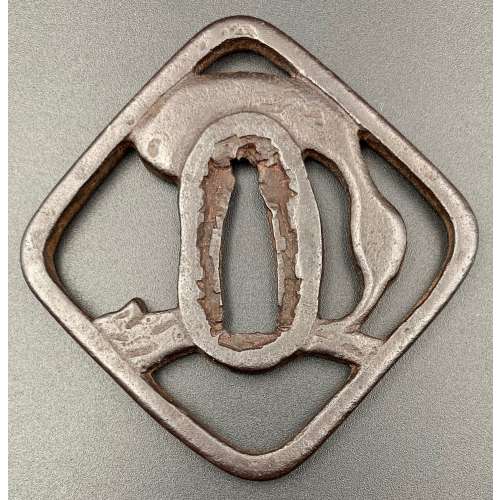
Iron tsuba of diamond form with rounded corners with the design of a double gourd on a branch in openwork. Dark brown patina. Ko-Shōami school. Custom kiri-wood box with hakogaki of Sasano Masayuki.
Momoyama Period (1574-1603)
Size: 77.1 x 75.7 x 4.6 mm; weight: 75.3 g.
Provenance: Sasano Masayuki[Translated by Markus Sesko]Hakogaki lid outside: 古正阿弥鐔 Ko-Shōami tsuba Hakogaki lid inside:Hyōtan-sukashi Mumei, Momoyama-ki saku Tetsu, ji-sukashi Koboku-aware no kasaku Heisei ninen Soshinkan Minazuki Openwork design of gourd Unsigned, Momoyama era work Iron, large openwork Masterwork full of classical charm. June of 1990, Soshinkan [pen name of Sasano Masayuki]瓢簞透 無銘 桃山期作 鉄地透
古撲惻之佳作 平成二年 素心鑑 水無月
-

Small iron tsuba (tantō size) of oval form carved with imitation of six overlapping plates, decorated with paulownia blossoms, leaves, and tendrils in brass and copper hira-zōgan. Copper sekigane. Open kozuka hitsu-ana.
Early Edo period, 17th century.
Size: 50.5 x 34.0 x 4.9 mm.
-

Small iron tsuba (tantō size) of aoi form with the design of paulownia leaves and blossoms in copper and brass flat inlay (hira-zōgan). Brass sekigane. Open kozuka hitsu-ana.
Early Edo period, 17th century.
Size: 53.4 x 40.7 x 4.4 mm; weight: 47.4 g
-
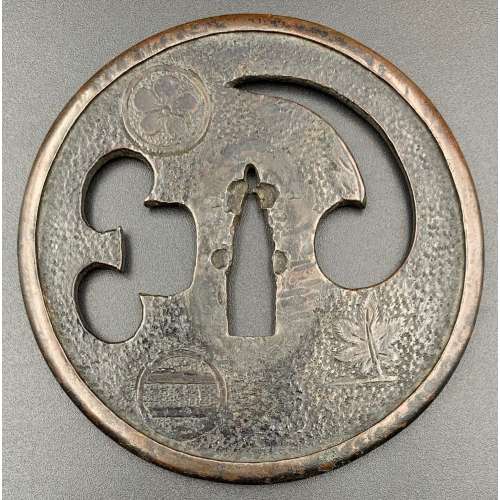
Yamagane (bronze) tsuba (kagamishi, or mirror-maker) with the design of tomoe (comma) and suhama in openwork. Surface treated with hammer marks and chiselled with the design of maple leaves and encircled two bars (maru-ni-futatsu-biki, Ashikaga clan family crest, or mon) on both sides. Raised rim or rim cover (fukurin). Custom kiri-wood box.
Size: 87.4 x 86.2 x 2.9 (center), 4.9 (rim) mm; weight: 120 g. -
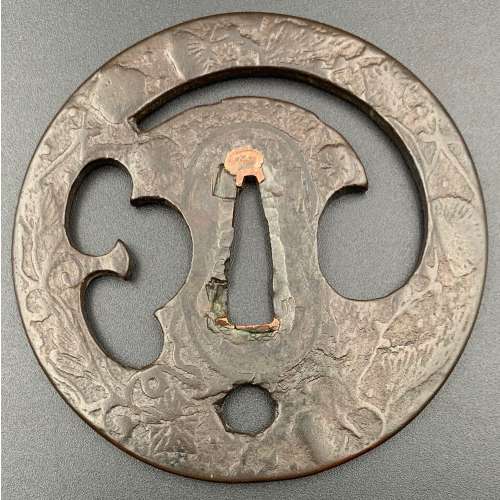
Yamagane (bronze) tsuba (kagami-shi, or mirror-maker) with the design of a star (round opening), tomoe (comma), and suhama in openwork. Surface cast and chiselled with the design of foliage, vines, blossoms, pine needles, and fruits on both sides.
The end of Early Muromachi period (1393-1453), circa 1450. Size: 83.7 x 84.1 x 3.6 (center), 4.1 (rim) mm; weight: 135.5 g. KANTEI-SHO (鑑定書) - APPRAISAL [translated by Markus Sesko]. No 463341 Tomoe-suhama-sukashi hana-karakusa no zu tsuba (巴洲浜透花唐草図鐔) ‒ Tsuba with stylized comma and bay inlet openwork and a flower and arabesque décor Unsigned: Kagami-shi (鏡師) Round shape, yamagane, hammer blow finish, cast, negative openwork design, round rim. According to the result of the shinsa committee of our society, we judge this work as authentic and rank it as Hozon Tōsōgu. July 1, 2011 [Foundation] Nihon Bijutsu Tōken Hozon Kyōkai, NBTHK (日本美術刀劍保存協會) -
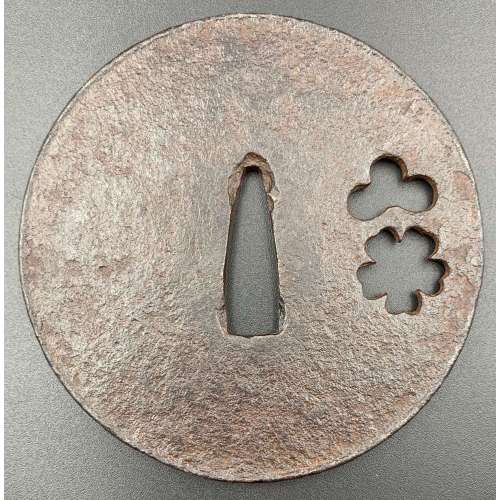
Iron tsuba with hammer marked surface and design of a plum and cherry blossoms to the right of nakaga-ana in openwork (sukashi). Raised rim, typical to katchushi school. The thickness of the plate provides for later Muromachi period making.
Late Muromachi period (1514-1573). Size: 85.8 x 85.0 x 3.6 (center), 4.1 (rim) mm; weight: 136 g. -
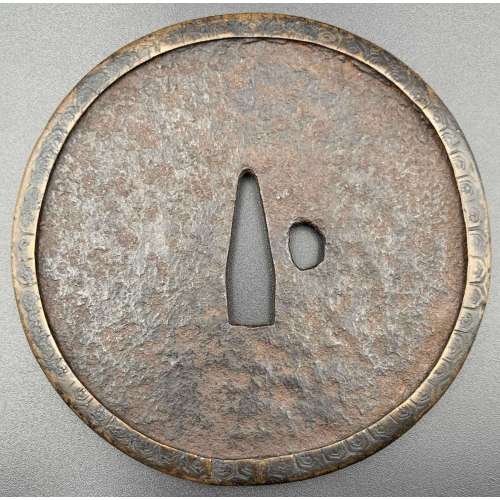
Large iron tsuba with hammer marks on the surface, small oval opening to the right of nakaga-ana; yamagane fukurin chiselled with tortois shell diaper pattern.
Early Muromachi period (1393-1453). Size: 101.2 x 101.9 x 2.4 (center), 5.2 (rim) mm; weight: 148.4 g.


